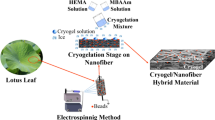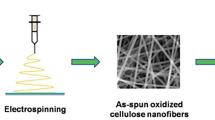Abstract
Unique structure-controllable three-dimensional (3D) nanofiber stacks of cellulose acetate (CA) were fabricated successfully by simply increasing relative humidity (RH) during the electrospinning process. It is found that once the RH exceeding 60 %, 3D flocculent nanofiber stacks would grow on the flat plate collector toward the needle tip without using special assisting apparatus or preparing special electrospinning solution. Compared with those obtained at low RH, the as-prepared nanofibers fabricated under high RH condition exhibited similar nanofiber diameter, density and porosity, and more importantly, 3D flocculent structures instead of typical two-dimensional (2D) electrospun non-woven mats, which would contribute to a significant improvement on the hydrophilicity. It is believed that rapid solidification of CA during the jet process and strong charge repulsion among CA nanofibers play important roles in the formation of 3D nanofibrous structure. Furthermore, these 3D flocculent nanofiber scaffolds exhibited better cytocompatibilities with human MG-63 cells than common 2D nanofibrous mats. Thus a facile and effective approach was presented to prepare 3D nanofiber stacks with tunable and reproducible properties for biodegradable scaffold applications.






Similar content being viewed by others
References
Bhardwaj N, Kundu SC (2010) Electrospinning: a fascinating fiber fabrication technique. Biotechnol Adv 28(3):325–347
Casper CL, Stephens JS, Tassi NG, Chase DB, Rabolt JF (2004) Controlling surface morphology of electrospun polystyrene fibers: effect of humidity and molecular weight in the electrospinning process. Macromolecules 37(2):573–578
De Schoenmaker B, Van der Schueren L, Zugle R, Goethals A, Westbroek P, Kiekens P, De Clerck K (2013) Effect of the relative humidity on the fibre morphology of polyamide 4.6 and polyamide 6.9 nanofibres. J Mater Sci 48(4):1746–1754
De Vrieze S, Van Camp T, Nelvig A, Hagström B, Westbroek P, De Clerck K (2009) The effect of temperature and humidity on electrospinning. J Mater Sci 44(5):1357–1362
Fashandi H, Karimi M (2012a) Pore formation in polystyrene fiber by superimposing temperature and relative humidity of electrospinning atmosphere. Polymer 53(25):5832–5849
Fashandi H, Karimi M (2012b) Characterization of porosity of polystyrene fibers electrospun at humid atmosphere. Thermochim Acta 547:38–46
Han SO, Youk JH, Min KD, Kang YO, Park WH (2008) Electrospinning of cellulose acetate nanofibers using a mixed solvent of acetic acid/water: effects of solvent composition on the fiber diameter. Mater Lett 62(4):759–762
Hardick O, Stevens B, Bracewell DG (2011) Nanofibre fabrication in a temperature and humidity controlled environment for improved fibre consistency. J Mater Sci 46(11):3890–3898
Hu H, Zhang X, He Y, Guo ZS, Zhang J, Song Y (2013) Combined effect of relative humidity and temperature on dynamic viscoelastic properties and glass transition of poly (vinyl alcohol). J Appl Polym Sci 130(5):3161–3167
Huang L, Bui NN, Manickam SS, McCutcheon JR (2011) Controlling electrospun nanofiber morphology and mechanical properties using humidity. J Polym Sci Part B Polym Phys 49(24):1734–1744
Konwarh R, Karak N, Misra M (2013) Electrospun cellulose acetate nanofibers: the present status and gamut of biotechnological applications. Biotechnol Adv 31(4):421–437
Liang T, Parhizkar M, Edirisinghe M, Mahalingam S (2014) Effect of humidity on the generation and control of the morphology of honeycomb-like polymeric structures by electrospinning. Eur Polym J 61:72–82
Liu H, Hsieh YL (2002) Ultrafine fibrous cellulose membranes from electrospinning of cellulose acetate. J Polym Sci B Polym Phys 40(18):2119–2129
Lu P, Xia Y (2013) Maneuvering the internal porosity and surface morphology of electrospun polystyrene yarns by controlling the solvent and relative humidity. Langmuir 29(23):7070–7078
Luo Y, Wang S, Shen M, Qi R, Fang Y, Guo R, Shi X (2013) Carbon nanotube-incorporated multilayered cellulose acetate nanofibers for tissue engineering applications. Carbohydr Polym 91(1):419–427
Ma Z, Ramakrishna S (2008) Electrospun regenerated cellulose nanofiber affinity membrane functionalized with protein A/G for IgG purification. J Membr Sci 319(1):23–28
Ma Z, Kotaki M, Ramakrishna S (2005) Electrospun cellulose nanofiber as affinity membrane. J Membr Sci 265(1):115–123
Müller CM, Laurindo JB, Yamashita F (2009) Effect of cellulose fibers on the crystallinity and mechanical properties of starch-based films at different relative humidity values. Carbohydr Polym 77(2):293–299
Nezarati RM, Eifert MB, Cosgriff-Hernandez E (2013) Effects of humidity and solution viscosity on electrospun fiber morphology. Tissue Eng C Methods 19(10):810–819
Nista SVG, Peres L, D’Ávila MA, Schmidt FL, Mei I, Lucia H (2012) Nanostructured membranes based on cellulose acetate obtained by electrospinning, part 1: study of the best solvents and conditions by design of experiments. J Appl Polym Sci 126(S1):E70–E78
Rodríguez K, Renneckar S, Gatenholm P (2011) Biomimetic calcium phosphate crystal mineralization on electrospun cellulose-based scaffolds. ACS Appl Mater Interfaces 3(3):681–689
Son WK, Youk JH, Lee TS, Park WH (2004) Electrospinning of ultrafine cellulose acetate fibers: studies of a new solvent system and deacetylation of ultrafine cellulose acetate fibers. J Polym Sci B Polym Phys 42(1):5–11
Sun B, Long YZ, Yu F, Li MM, Zhang HD, Lia WJ, Xu TX (2012) Self-assembly of a three-dimensional fibrous polymer sponge by electrospinning. Nanoscale 4(6):2134–2137
Sun B, Long YZ, Zhang HD, Li MM, Duvail JL, Jiang XY, Yin HL (2014) Advances in three-dimensional nanofibrous macrostructures via electrospinning. Prog Polym Sci 39(5):862–890
Tungprapa S, Puangparn T, Weerasombut M, Jangchud I, Fakum P, Semongkhol S, Meechaisue C, Supaphol P (2007) Electrospun cellulose acetate fibers: effect of solvent system on morphology and fiber diameter. Cellulose 14(6):563–575
Wu S, Qin X, Li M (2014) The structure and properties of cellulose acetate materials: a comparative study on electrospun membranes and casted films. J Ind Text 44(1):85–98
Yousefzadeh M, Latifi M, Amani-Tehran M, Teo W, Ramakrishna S (2012) A note on the 3D structural design of electrospun nanofibers. J Eng Fabr Fibers (JEFF) 7(2):17–23
Yu DG, Yu JH, Chen L, Williams GR, Wang X (2012) Modified coaxial electrospinning for the preparation of high-quality ketoprofen-loaded cellulose acetate nanofibers. Carbohydr Polym 90(2):1016–1023
Yu HY, Qin ZY, Yan CF, Yao JM (2014) Green nanocomposites based on functionalized cellulose nanocrystals: a study on the relationship between interfacial interaction and property enhancement. ACS Sustain Chem Eng 2(4):875–886
Acknowledgments
This work has been financially supported by Program for Changjiang Scholars and Innovative Research Team in University (IRT1221) and Key Basic Research Project of Science and Technology of Shanghai (15Q10622). Dr. Miao Cheng kindly acknowledges the support from the Innovation Research Funds for the Doctoral candidate of Donghua University (15D310606). Dr. Hou-Yong Yu would like to thank the support from the State Key Laboratory for Modification of Chemical Fibers and Polymer Materials, Donghua University (LK1428).
Author information
Authors and Affiliations
Corresponding authors
Rights and permissions
About this article
Cite this article
Cheng, M., Qin, Z., Hu, S. et al. Use of electrospinning to directly fabricate three-dimensional nanofiber stacks of cellulose acetate under high relative humidity condition. Cellulose 24, 219–229 (2017). https://doi.org/10.1007/s10570-016-1099-3
Received:
Accepted:
Published:
Issue Date:
DOI: https://doi.org/10.1007/s10570-016-1099-3




